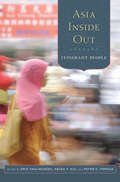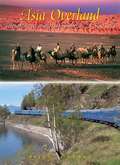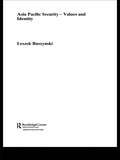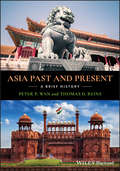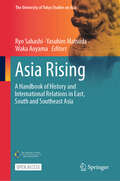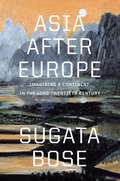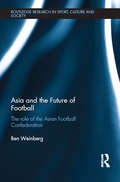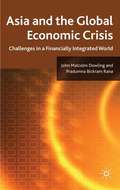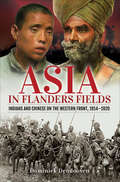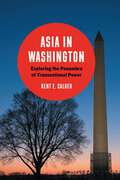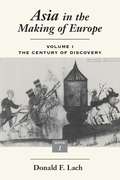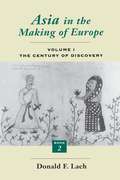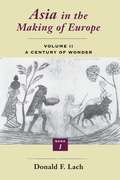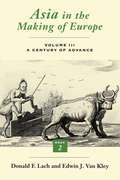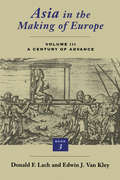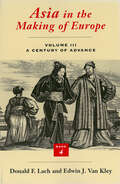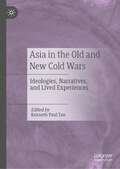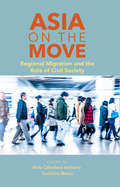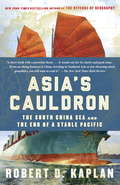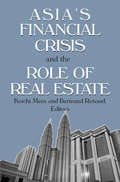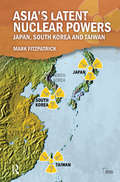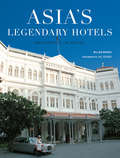- Table View
- List View
Asia Inside Out: Itinerant People
by Eric TagliacozzoIn the final volume of Asia Inside Out, a stellar interdisciplinary team of scholars shows the ways that itinerant groups criss-crossing the continent have transformed their culture and surroundings. Going beyond time and place, which animated the first two books, this third one looks at human beings on the move.
Asia Overland: Tales of Travel on the Trans-Siberian & Silk Road
by Bijan OmraniThe story of travel through the centuries along Eurasia's great land routes, told through the observations and accounts of many of the world's great travelers, and enhanced by wonderful illustrations both old and new. What was it really like to travel the iron rails of the Trans-Siberian Railway in its early years, the dusty, parched tracks of the Silk Road in its heyday, or the rugged, dangerous mountain passes into and out of the Indian subcontinent? Eurasia's great land routes, offspring of the ambition of Russian tsars, Chinese emperors and Mughal khans, have served human history well, acting as conduits for trade, religion and cultural conventions, and as avenues down which conquering armies and commercial pioneers swarmed in the forging of empires. With wit and humor, Omrani weaves a tapestry of tales and reports by a panoply of travelers down the centuries, taking the reader on an exciting journey that crosses continents and spans epochs. Richly embellished with stunning photography, detailed maps and fascinating archival illustrations, Asia Overland is a compelling piece of travel literature that will appeal to both modern-day explorers and armchair travelers alike. Travel companion and historical travelogue Resourced from travel luminaries: from George Kennan to Anton Chekhov, Fa Xian and Xuanzang to Marco Polo and Matteo Ricci, Sir Clarmont Skrine and Francis Younghusband to Peter Fleming and Mildred Cable, Lord Curzon and Sir Alexander Burnes to Yakut al-Hamawi and Ruy Gonzáles de Clavijo Fascinating archival images Lavish, broad-ranging photography
Asia Pacific Security - Values and Identity (Routledge Security In Asia Ser.)
by Leszek BuszynskiThe main theme of this book is that security is not just about defence from external attack, but embraces the protection of identity and values which cultures regard as important, and which they may regard as worth fighting for. It examines Asia Pacific security from the perspective of the values and identities of the major actors in the region - C
Asia Past and Present: A Brief History
by Peter P. Wan Thomas D. ReinsA wide-ranging introduction to the multi-faceted history of Asia—from early origins to the present Asia Past and Present is an expansive survey of the social, political, and economic history of the continent from the Paleolithic era to the early 21st century. As there is no physically discrete continent, rather an arbitrary division of the Eurasian landmass, this book focuses on terrain that encompasses India, Pakistan, Afghanistan, Central Asia, China, Korea, Japan, Mongolia, the Russian Far East, and Southeast Asia—the area which most modern scholars identify as Asia. Offering broad chronological and topical coverage of Asia, this book examines subjects including written languages, religions and philosophies, concepts of monarchy, militarism, independence and nation building, and more. Particular focus is placed on the varying levels of influence the core cultures of India and China have had on the continent in a multitude of socio-political areas. Historical dialogues of how colonies, later emerging nations, blended traditional Asian culture and Western political and economic models of modernization complement contemporary discussions of globalization, nuclear tensions, and growing demands for greater individual freedom. Written in an engaging, accessible style, this book: Covers of a wide range of topics, perspectives, geographic regions, and time periods Highlights India and China as the pre 19th century cultural cores of Asia Presents a relatable political-cultural narrative framework Discusses contemporary themes including gender, sexual orientation, the environment, and Western and Islamic influence on Asian culture Includes coverage of commonly underrepresented regions such as the Himalayan nations, Maldives, and New Guinea Asia Past and Present: A Brief History is a valuable resource for undergraduate courses where Asian cultures are introduced, and in courses on Asian politics, diplomacy, environmental issues, and socio-economics.
Asia Rising: A Handbook of History and International Relations in East, South and Southeast Asia (The University of Tokyo Studies on Asia)
by Ryo Sahashi Yasuhiro Matsuda Waka AoyamaThis open-access book offers a clear and thorough exploration of Asia's history from an international relations perspective. The book investigates key political, economic, and cultural forces defining Asia. It highlights the historical and current significance of the Indo-Pacific region, particularly shedding light on its strategic role in global geopolitics. Through detailed historical analyses, the authors guide readers toward a comprehensive understanding of Asia's complex international relations, from colonization and imperialism, through the Cold War, into decolonization and the wave of democratization in the region, to the rise of China, unpacking the various dimensions of regionalism in Asia. This book serves as a practical scholarly resource for advanced students, researchers, and lecturers interested in understanding the region's past and its implications for future geopolitical dynamics. It is relevant to historians focused on Asia and to international relations and political science scholars interested in the shift to an Asian world order, from past to present.
Asia after Europe: Imagining a Continent in the Long Twentieth Century
by Sugata BoseA concise new history of a century of struggles to define Asian identity and express alternatives to European forms of universalism.The balance of global power changed profoundly over the course of the twentieth century, above all with the economic and political rise of Asia. Asia after Europe is a bold new interpretation of the period, focusing on the conflicting and overlapping ways in which Asians have conceived their bonds and their roles in the world. Tracking the circulation of ideas and people across colonial and national borders, Sugata Bose explores developments in Asian thought, art, and politics that defied Euro-American models and defined Asianness as a locus of solidarity for all humanity.Impressive in scale, yet driven by the stories of fascinating and influential individuals, Asia after Europe examines early intimations of Asian solidarity and universalism preceding Japan’s victory over Russia in 1905; the revolutionary collaborations of the First World War and its aftermath, when Asian universalism took shape alongside Wilsonian internationalism and Bolshevism; the impact of the Great Depression and Second World War on the idea of Asia; and the persistence of forms of Asian universalism in the postwar period, despite the consolidation of postcolonial nation-states on a European model.Diverse Asian universalisms were forged and fractured through phases of poverty and prosperity, among elites and common people, throughout the span of the twentieth century. Noting the endurance of nationalist rivalries, often tied to religious exclusion and violence, Bose concludes with reflections on the continuing potential of political thought beyond European definitions of reason, nation, and identity.
Asia and the Future of Football: The Role of the Asian Football Confederation (Routledge Research in Sport, Culture and Society)
by Ben WeinbergFootball is the most popular sport in the world. Globalisation and commercialisation of the game, however, have created new conflicts and challenges. This book explores the role of the Asian Football Confederation (AFC) within the rising significance of football in Asia, drawing on three key theoretical perspectives: globalisation, neo-institutionalism and governance, as well as comprehensive data from interviews and archive material. It explores the organisational structure of AFC, its decision-making processes, relations with other actors, and policies put forward. To understand the specificities AFC has faced in its 60-year history, the broader historical, political, economic, socio-cultural and geographic contexts of football in Asia are taken into account.
Asia and the Global Economic Crisis
by John Malcolm Dowling Pradumna Bickram RanaThis book provides an analysis of the global economic crisis from an Asian perspective. It examines the impacts of the policy measures adopted, the remaining challenges in rebalancing the global economy, the next steps in regional economic integration in Asia, and issues related to reform of the international financial architecture.
Asia in Flanders Fields: Indians and Chinese on the Western Front, 1914–1920
by Dominiek DendoovenThe First World War brought peoples from five continents to support the British and French Allies on the Western Front. Many were from colonial territories in the British and French empires, and the largest contingents were Indians and Chinese - some 140,000. It is a story of the encounter with the European 'other', including the civilian European local populations, often marred by racism, discrimination and zenophobia both inside and outside the military command, but also lightened by moving and enduring 'human' social relationships. The vital contribution to the Alles and the huge sacrifices involved were scarcely recognised at the Paris Peace Conference in 1918 or the post-war victory celebrations and this led to resentment - see huge media coverage in 2021. The effect of the European 'other' experience enhanced Asian political awareness and self-confidence, and stimulated anti-imperialism and proto-nationalism. This is a vivid and original contribution to imperial decline from the First World War. and the originality of the work is enhanced by rare sources culled from original documents and 'local' European fieldwork - in French, German and Flemish.
Asia in Washington
by Kent E. CalderFor several centuries, international relations has been primarily the purview of nation-states. Key powers have included at various times Great Britain, France, Japan, China, Russia (then the U.S.S.R., and then Russia again), and the nation most influential in international relations for the past several decades has been the United States. But in a world growing smaller, with a globalizing system increasing in complexity by the day, the nation-state paradigm is not as dominant as it once was.In Asia in Washington, longtime Asia analyst Kent Calder examines the concept of "global city" in the context of international affairs. The term typically has been used in an economic context, referring to centers of international finance and commerce such as New York, Tokyo, and London. But Calder extends the concept to political centers as well--particularly in this case, Washington, D.C.Improved communications, enhanced transportation, greater economic integration and activity have created a new economic village, and global political cities are arising within the new structure--distinguished not by their CEOs or stock markets but by their influence over policy decisions, and their amassing of strategic intelligence on topics from national policy trends to geopolitical risk. Calder describes the rise of Washington, D.C., as perhaps the preeminent global political city--seat of the world's most powerful government, center of NGO and multilateral policy activity, the locale of institutions such as the World Bank and IMF, and home to numerous think tanks and universities.Within Washington, the role of Asia is especially relevant for several reasons. It represents the core of the non-Western industrialized world and the most challenge to Western dominance. It also raises the delicate issue of how race matters in international global governance--a factor crucially important during a time of globalization. And since Asia developed later than the West, its changing role in Washington raises major issues regarding how rising powers assimilate themselves into global governance structure. How do Asian nations establish, increase, and leverage their Washington presence, and what is the impact on Washington itself and the decisions made there? Kent Calder explains it all in Asia in Washington.
Asia in Washington
by Kent E. CalderFor several centuries, international relations has been primarily the purview of nation-states. Key powers have included at various times Great Britain, France, Japan, China, Russia (then the U.S.S.R., and then Russia again), and the nation most influential in international relations for the past several decades has been the United States. But in a world growing smaller, with a globalizing system increasing in complexity by the day, the nation-state paradigm is not as dominant as it once was.In Asia in Washington, longtime Asia analyst Kent Calder examines the concept of "global city" in the context of international affairs. The term typically has been used in an economic context, referring to centers of international finance and commerce such as New York, Tokyo, and London. But Calder extends the concept to political centers as well-particularly in this case, Washington, D.C.Improved communications, enhanced transportation, greater economic integration and activity have created a new economic village, and global political cities are arising within the new structure-distinguished not by their CEOs or stock markets but by their influence over policy decisions, and their amassing of strategic intelligence on topics from national policy trends to geopolitical risk.Calder describes the rise of Washington, D.C., as perhaps the preeminent global political city-seat of the world's most powerful government, center of NGO and multilateral policy activity, the locale of institutions such as the World Bank and IMF, and home to numerous think tanks and universities.Within Washington, the role of Asia is especially relevant for several reasons. It represents the core of the non-Western industrialized world and the most challenge to Western dominance. It also raises the delicate issue of how race matters in international global governance-a factor crucially important during a time of globalization. And since Asia developed later than the West, its changing role in Washington raises major issues regarding how rising powers assimilate themselves into global governance structure. How do Asian nations establish, increase, and leverage their Washington presence, and what is the impact on Washington itself and the decisions made there? Kent Calder explains it all in Asia in Washington.
Asia in the Making of Europe, Volume I: The Century of Discovery. Book 1.
by Donald F. LachPraised for its scope and depth, Asia in the Making of Europe is the first comprehensive study of Asian influences on Western culture. <P><P>For volumes I and II, the author has sifted through virtually every European reference to Asia published in the sixteenth-century; he surveys a vast array of writings describing Asian life and society, the images of Asia that emerge from those writings, and, in turn, the reflections of those images in European literature and art. <P><P>This monumental achievement reveals profound and pervasive influences of Asian societies on developing Western culture; in doing so, it provides a perspective necessary for a balanced view of world history. <P><P> Volume I: The Century of Discovery brings together "everything that a European could know of India, Southeast Asia, China, and Japan, from printed books, missionary reports, traders' accounts and maps" (The New York Review of Books). Volume II: A Century of Wonder examines the influence of that vast new body of information about Asia on the arts, institutions, literatures, and ideas of sixteenth-century Europe.
Asia in the Making of Europe, Volume I: The Century of Discovery. Book 2.
by Donald F. LachPraised for its scope and depth, Asia in the Making of Europe is the first comprehensive study of Asian influences on Western culture. For volumes I and II, the author has sifted through virtually every European reference to Asia published in the sixteenth-century; he surveys a vast array of writings describing Asian life and society, the images of Asia that emerge from those writings, and, in turn, the reflections of those images in European literature and art. This monumental achievement reveals profound and pervasive influences of Asian societies on developing Western culture; in doing so, it provides a perspective necessary for a balanced view of world history. Volume I: The Century of Discovery brings together "everything that a European could know of India, Southeast Asia, China, and Japan, from printed books, missionary reports, traders' accounts and maps" (The New York Review of Books). Volume II: A Century of Wonder examines the influence of that vast new body of information about Asia on the arts, institutions, literatures, and ideas of sixteenth-century Europe.
Asia in the Making of Europe, Volume II: A Century of Wonder. Book 1: The Visual Arts
by Donald F. LachThis is the second volume in a series that traces, century by century, the role of Asia in the making of Europe. The rise to world dominance of the Western nations in modern times and the rapid industrial growth of the West, which outpaced the East in technical and military achievements, have led to a historical eclipse of the ancient and brilliant cultures of Asia. Historican Donald F. Lach, in his influential scholarly work, Asia in the Making of Europe, points out that an eclipse is never permanent, that this one was never total, and that there was a period in early modern times when Asia and Europe were close rivals in brilliance and mutual influence.
Asia in the Making of Europe, Volume III: A Century of Advance. Book 2, South Asia
by Donald F. Lach Edwin J. Van KleyThis monumental series, acclaimed as a "masterpiece of comprehensive scholarship" in the New York Times Book Review, reveals the impact of Asia's high civilizations on the development of modern Western society. The authors examine the ways in which European encounters with Asia have altered the development of Western society, art, literature, science, and religion since the Renaissance. In Volume III: A Century of Advance, the authors have researched seventeenth-century European writings on Asia in an effort to understand how contemporaries saw Asian societies and peoples.
Asia in the Making of Europe, Volume III: A Century of Advance. Book 1: Trade, Missions, Literature
by Donald F. Lach Edwin J. Van KleyThis monumental series, acclaimed as a "masterpiece of comprehensive scholarship" in the New York Times Book Review, reveals the impact of Asia's high civilizations on the development of modern Western society. The authors examine the ways in which European encounters with Asia have altered the development of Western society, art, literature, science, and religion since the Renaissance. In Volume III: A Century of Advance, the authors have researched seventeenth-century European writings on Asia in an effort to understand how contemporaries saw Asian societies and peoples.
Asia in the Making of Europe, Volume III: A Century of Advance. Book 3: Southeast Asia
by Donald F. Lach Edwin J. Van KleyThis monumental series, acclaimed as a "masterpiece of comprehensive scholarship" in the New York Times Book Review, reveals the impact of Asia's high civilizations on the development of modern Western society. The authors examine the ways in which European encounters with Asia have altered the development of Western society, art, literature, science, and religion since the Renaissance. In Volume III: A Century of Advance, the authors have researched seventeenth-century European writings on Asia in an effort to understand how contemporaries saw Asian societies and peoples. Book 3: Southeast Asia examines European images of the lands, societies, religions, and cultures of Southeast Asia. The continental nations of Siam, Vietnam, Malaya, Pegu, Arakan, Cambodia, and Laos are discussed, as are the islands of Java, Bali, Sumatra, Borneo, Amboina, the Moluccas, the Bandas, Celebes, the Lesser Sundas, New Guinea, Australia, New Zealand, the Philippines, Mindanao, Jolo, Guam, and the Marianas.
Asia in the Making of Europe, Volume III: A Century of Advance. Book 3: Southeast Asia
by Donald F. Lach Edwin J. Van KleyThis monumental series, acclaimed as a "masterpiece of comprehensive scholarship" in the New York Times Book Review, reveals the impact of Asia's high civilizations on the development of modern Western society. The authors examine the ways in which European encounters with Asia have altered the development of Western society, art, literature, science, and religion since the Renaissance. In Volume III: A Century of Advance, the authors have researched seventeenth-century European writings on Asia in an effort to understand how contemporaries saw Asian societies and peoples. Book 3: Southeast Asia examines European images of the lands, societies, religions, and cultures of Southeast Asia. The continental nations of Siam, Vietnam, Malaya, Pegu, Arakan, Cambodia, and Laos are discussed, as are the islands of Java, Bali, Sumatra, Borneo, Amboina, the Moluccas, the Bandas, Celebes, the Lesser Sundas, New Guinea, Australia, New Zealand, the Philippines, Mindanao, Jolo, Guam, and the Marianas.
Asia in the Making of Europe, Volume III: A Century of Advance. Book 4: East Asia
by Donald F. Lach Edwin J. Van KleyThis monumental series, acclaimed as a "masterpiece of comprehensive scholarship" in the New York Times Book Review, reveals the impact of Asia's high civilizations on the development of modern Western society. The authors examine the ways in which European encounters with Asia have altered the development of Western society, art, literature, science, and religion since the Renaissance. In Volume III: A Century of Advance, the authors have researched seventeenth-century European writings on Asia in an effort to understand how contemporaries saw Asian societies and peoples.
Asia in the Old and New Cold Wars: Ideologies, Narratives, and Lived Experiences
by Kenneth Paul TanThis is a collection of essays marking the 30th anniversary of the historic Cold War’s formal conclusion in 1991. It enriches Cold War studies—a field dominated by Political Science, International Relations, and History—with insights from Sociology, Anthropology, Cultural Studies, and Film and Media Studies. Through critical analysis of newspaper and magazine articles, films, novels, art exhibits, museums, and other commemorative sites that engage with the themes of conflict, violence, trauma, displacement, marginalization, ecology, and identity, the book provides rich and diverse perspectives on the complex relationship between the historic Cold War and its legacies on the one hand and, on the other, their impact on Asia, its plural histories and peoples, and their shifting identities, ideological beliefs, and lived experiences. Today, we often speak of an ‘Asian century’ and witness intensifying concerns over ‘new cold wars’ or ‘Cold War 2.0’. A United States in decline and a China on the rise create conditions for a new superpower rivalry, with a trade war already being fought between the two competitors. Russia continues to flex its geopolitical muscles, launching a full-scale invasion of neighbouring Ukraine in 2022, as its strongman leadership yearns nostalgically for the good old days of the USSR. As grand narratives and strategies of the Cold War jostle to make sense of high-level geopolitical events, this book descends to the level of lived experience, zooming in on ordinary and marginalized peoples, whose lives and livelihoods have been affected over the decades by the Cold War and its legacies.
Asia on the Move: Regional Migration and the Role of Civil Society
by Mely Caballero-Anthony Toshihiro MenjuGlobalization has led to a surge in cross-border migration, leading the number of international migrants in East Asia to more than double over the past two decades. Carefully managed migration can spark economic growth and innovation, while helping destination countries with aging populations overcome human resource constraints. However, irregular migration has been on the rise as well, which not only places migrants in a vulnerable position with no legal recourse but also is linked to trafficking, smuggling, and even terrorism. Clearly, migration-whether regular or irregular-needs to be managed more effectively to handle the expanding and increasingly complex flows of people as well as the human security challenges they bring. In this volume, experts from "sending" and "receiving" countries in Northeast and Southeast Asia identify current migration trends, analyze government efforts to manage migration, and explore the unique role that nongovernmental organizations can play in helping to protect migrants and to harness migration to the benefit of the region.
Asia's Cauldron: The South China Sea and the End of a Stable Pacific
by Robert D. KaplanFrom Robert D. Kaplan, named one of the world's Top 100 Global Thinkers by Foreign Policy magazine, comes a penetrating look at the volatile region that will dominate the future of geopolitical conflict. Over the last decade, the center of world power has been quietly shifting from Europe to Asia. With oil reserves of several billion barrels, an estimated nine hundred trillion cubic feet of natural gas, and several centuries' worth of competing territorial claims, the South China Sea in particular is a simmering pot of potential conflict. The underreported military buildup in the area where the Western Pacific meets the Indian Ocean means that it will likely be a hinge point for global war and peace for the foreseeable future. In Asia's Cauldron, Robert D. Kaplan offers up a vivid snapshot of the nations surrounding the South China Sea, the conflicts brewing in the region at the dawn of the twenty-first century, and their implications for global peace and stability. One of the world's most perceptive foreign policy experts, Kaplan interprets America's interests in Asia in the context of an increasingly assertive China. He explains how the region's unique geography fosters the growth of navies but also impedes aggression. And he draws a striking parallel between China's quest for hegemony in the South China Sea and the United States' imperial adventure in the Caribbean more than a century ago. To understand the future of conflict in East Asia, Kaplan argues, one must understand the goals and motivations of its leaders and its people. Part travelogue, part geopolitical primer, Asia's Cauldron takes us on a journey through the region's boom cities and ramshackle slums: from Vietnam, where the superfueled capitalism of the erstwhile colonial capital, Saigon, inspires the geostrategic pretensions of the official seat of government in Hanoi, to Malaysia, where a unique mix of authoritarian Islam and Western-style consumerism creates quite possibly the ultimate postmodern society; and from Singapore, whose "benevolent autocracy" helped foster an economic miracle, to the Philippines, where a different brand of authoritarianism under Ferdinand Marcos led not to economic growth but to decades of corruption and crime. At a time when every day's news seems to contain some new story--large or small--that directly relates to conflicts over the South China Sea, Asia's Cauldron is an indispensable guide to a corner of the globe that will affect all of our lives for years to come.Advance praise for Asia's Cauldron "Asia's Cauldron is a perfect summation of the present turbulent moment in history, when the World War II security structure is beginning a rapid transformation. Kaplan engages the striking possibilities of where the current confrontation between China and Japan could lead, and underscores the point that this is a lot more significant than a simple border dispute."--Paul Bracken, Yale University, author of The Second Nuclear Age "Master global strategist Robert D. Kaplan turns his gaze to the bubbling heat of the South China Sea in his latest tour de force. Asia's Cauldron deconstructs the extreme volatility of this enormous, dangerous, and vital maritime space."--Admiral James Stavridis, United States Navy (Ret.), dean of the Fletcher School at Tufts University and Supreme Allied Commander of the North Atlantic Treaty Organization, 2009-2013From the Hardcover edition.
Asia's Financial Crisis and the Role of Real Estate
by Bertrand Renaud Koichi MeraThis book by a distinguished academic and a professional economist from the World Bank clearly demonstrates the significant role played by the real estate sector in inducing the Asian crisis; the linkage of the real estate sector to the general economy; the causes of real estate booms and subsequent busts; and the economic costs of real estate price volatility. The book also includes suggestions for moderating such volatility in the future.
Asia's Latent Nuclear Powers: Japan, South Korea and Taiwan (Adelphi series)
by Mark FitzpatrickIf the nuclear weapons club were to further expand, would America�s democratic allies in Northeast Asia be among the next entrants? Japan, South Korea and Taiwan all have robust civilian nuclear energy programmes that make them �virtual nuclear powers� according to many analysts. All three once pursued nuclear weapons and all face growing security threats from nuclear-armed adversaries. But will they � or rather, under what circumstances might they? This book analyses these past nuclear pursuits and current proliferation drivers. In explaining the nuclear technology that the three now possess, it considers how long it would take each to build a nuclear weapon if such a fateful decision were made. Although nuclear dominoes Northeast Asia cannot be ruled out, the author does not predict such a scenario. Unlike when each previously went down a nuclear path, democracy and a free press now prevail as barriers to building nukes in the basement. Reliance on US defence commitments is a better security alternative -- as long as such guarantees remain credible, an issue that is also assessed. But extended deterrence is not a tight barrier to proliferation of sensitive nuclear technologies. Nuclear hedging by its Northeast Asian partners will challenge Washington�s nuclear diplomacy.
Asia's Legendary Hotels
by William Warren Jill GocherAssia's Legendary Hotels features some of Asia's most significant hotels, renowned for their rich histories and superb levels of service and luxury. From the Raffles Hotel in SIngapore, to the Ananda in the Himalaya, these grand dames capture the romance of travel days gone by, when the journey itself was as much of an adventure as the destination. Their unique architecture and luxurious interiros are captured in over 370 stunning full-color photographs and rare archival images showcase their rich histories.
